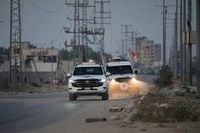On October 30, 2025, a somber but significant step unfolded in the ongoing Israel-Hamas conflict: Palestinian militants handed over the remains of two more Israeli hostages to the Red Cross in Gaza, a move seen as both a humanitarian gesture and a barometer of the fragile ceasefire’s progress. According to the Associated Press, the remains were then transported into Israel by military personnel and taken to the National Institute of Forensic Medicine for formal identification.
Late Thursday, Israeli Prime Minister Benjamin Netanyahu’s office confirmed that the remains belonged to Sahar Baruch and Amiram Cooper, two of the many Israelis taken hostage during the devastating October 7, 2023, attack by Hamas that triggered the current war. This latest transfer brings the total number of hostages’ remains returned by Hamas to 17 since the start of the ceasefire, with 11 more still reportedly in Gaza and expected to be handed over under the terms of the ongoing agreement.
The return of hostages’ remains is part of a broader, uneasy exchange. In return, Israel has sent back the bodies of 195 Palestinians to authorities in Gaza, though, as reported by AP, no details have been provided regarding their identities. The uncertainty surrounding these bodies is compounded by the fact that Gaza’s health officials have struggled to identify them due to a lack of DNA kits. It remains unclear whether the deceased Palestinians were killed during the October 7 attack inside Israel, died in Israeli custody, or were recovered from Gaza during the subsequent war.
The personal stories behind the names bring a human face to the statistics. Sahar Baruch, just 25 years old, was preparing to pursue an electrical engineering degree when he was taken hostage from Kibbutz Be’eri. His family suffered a double tragedy, as his brother Idan was killed during the same attack. Three months into Sahar’s captivity, the Israeli military announced he had been killed during an attempted rescue mission. Amiram Cooper, on the other hand, was an 84-year-old economist and one of the founders of Kibbutz Nir Oz. He and his wife, Nurit, were both captured; she was released after 17 days, but in June 2024, Israeli officials confirmed that Amiram had been killed in Gaza.
While these exchanges were taking place, violence continued to flare. On the night spanning October 29–30, at least 40 people were injured in Israeli airstrikes on Khan Younis in southern Gaza, as reported by Mohammad Saar, head of the nursing department at Nasser Hospital. The Israeli army stated that these strikes targeted what it described as "terrorist infrastructure that posed a threat to the troops" in Khan Younis, an area currently under Israeli military control.
The resumption of strikes came just after Israel declared the ceasefire was back in effect on October 29, following a brief but deadly escalation earlier in the week. Those earlier strikes, according to AP, killed more than 100 people and were in retaliation for the shooting and killing of an Israeli soldier in Rafah, Gaza’s southernmost city. The tit-for-tat violence underscores the fragility of the ceasefire and the deep mistrust on both sides.
Prime Minister Netanyahu was blunt in his assessment of the situation. Speaking at a graduation ceremony for military commanders in southern Israel on October 30, he warned, "If Hamas continues to blatantly violate the ceasefire, it will experience powerful strikes, as it did the day before yesterday and yesterday." Netanyahu emphasized Israel’s resolve, stating that the Israeli military would "act as needed" to remove any "immediate danger" to its forces. He added, "At the end of the day, Hamas will be disarmed and Gaza will be demilitarized. If foreign forces do this, all the better. And if they don’t, we will do it."
The ceasefire, which officially began on October 10, 2025, was intended to wind down what has become the deadliest and most destructive war ever fought between Israel and Hamas. The conflict was set off by the October 7, 2023, attack on Israel by Hamas-led militants, which killed about 1,200 people and resulted in 251 hostages being taken. The scale of the violence since then has been staggering. According to Gaza’s Health Ministry, more than 68,600 Palestinians have been killed in Gaza since the war began. It’s important to note, as AP does, that the ministry is part of the Hamas-run government but is staffed by medical professionals and maintains detailed records that independent experts generally regard as reliable. Still, Israel has disputed these figures, and some international critics have accused Israel of committing genocide in Gaza—a charge the Israeli government vehemently denies, though it has not provided its own casualty count.
Amid these grim statistics, the process of returning remains—both Israeli and Palestinian—has become a focal point in the broader negotiations and a symbol of the deep pain on both sides. For Israeli families, the return of loved ones’ remains brings a measure of closure, albeit a heartbreaking one. For Palestinians, the return of bodies, even without identification, provides a chance for burial rites and remembrance, though the lack of resources for proper identification leaves many families in prolonged uncertainty.
The underlying tension was evident as both sides accused each other of violating the ceasefire agreement. Netanyahu claimed Hamas had breached provisions related to the handover of hostages’ remains, while Hamas denied any involvement in the deadly shooting of the Israeli soldier and, in turn, accused Israel of breaking the ceasefire deal. This mutual distrust has made every step forward fraught with risk and suspicion.
The international community, meanwhile, watches closely. The Red Cross’s role as an intermediary in the transfer of remains underscores the importance of neutral organizations in facilitating humanitarian actions amid conflict. Yet, the broader questions—how to achieve a lasting peace, how to address the underlying grievances, and how to prevent further bloodshed—remain unanswered.
For now, the ceasefire holds, albeit tenuously. The exchange of remains continues, offering small moments of humanity amid the devastation. But with warnings from Israeli leadership and ongoing violence on the ground, the path to a true and lasting peace remains as uncertain as ever. Each new development, whether a handover of remains or a fresh round of airstrikes, reminds the world of the immense human cost of this conflict and the urgent need for a durable solution.

